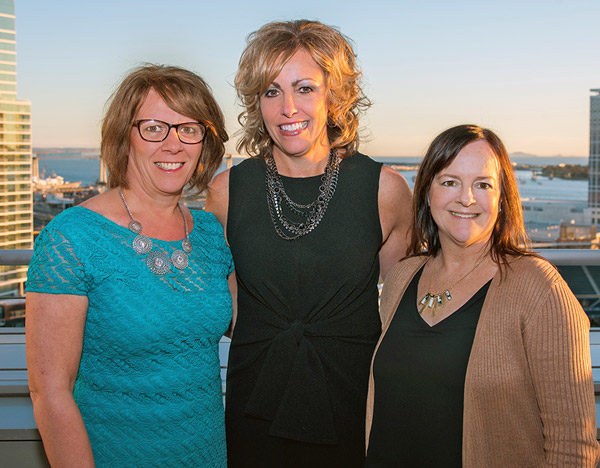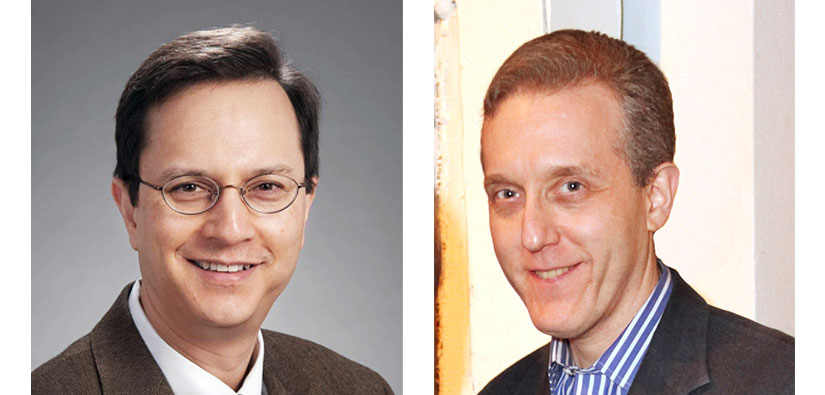The Skin Cancer Foundation’s Research Grants Program has given young physicians and investigators a special boost for studies that served as stepping stones to major lifesaving breakthroughs. It has also cemented bonds between the Foundation, donors and some of the world’s most important skin cancer researchers.
By MARK TEICH
Sometimes, one helpful push can change the world.
Over the years, The Skin Cancer Foundation’s Research Grants program has provided more than $1.6 million to young physicians and investigators launching worthy studies on skin cancer. Each year, the six-member team of physicians on our Research Grants Committee exhaustively evaluates numerous proposals submitted by dermatology residents, fellows and young faculty members. Some of the winners go on to become leading researchers in their field, while others take their knowledge and apply it to direct patient care. Many do both.
Sometimes, the grants prove to be just the catalyst they need for bigger things, while also leading to dynamic, enduring relationships between the investigators and the Foundation. Two of the trailblazers in their respective areas of skin cancer research and treatment, dermatologist Paul Nghiem, MD, and medical oncologist Jedd Wolchok, MD, have worked with the Foundation on many important projects after receiving our grants, helping to bolster the educational programs we offer. Both credit The Skin Cancer Foundation for funding early work that went on to make a major difference.
TOP PHOTO: Pioneers in Their Fields. The grant Paul Nghiem, MD (left), received in 2007 helped lead to the first approved drug to treat dangerous Merkel cell carcinomas. Jedd Wolchok, MD (right), says his 2011 grant taught researchers more about the biology of new medicines for advanced melanoma and how to combine them.
Breakthroughs in Merkel Cell Carcinoma
In 2007, Dr. Nghiem, then assistant professor in the Department of Medicine, Division of Dermatology, at the University of Washington in Seattle, received a grant from the Foundation for his project, “Merkel Cell Carcinoma: Building a Tumor and Cell Line Toolbox.” Merkel cell carcinoma (MCC), a rare skin cancer, is harder to detect than melanoma and metastasizes much earlier in its development, often spreading to the lymph nodes by the time it is diagnosed.
When Dr. Nghiem received the grant, the incidence of MCC had tripled in the previous 15 years, making it the second leading cause of nonmelanoma skin cancer deaths. Yet very little was known about its molecular basis, and little research existed on how to treat it. “There was a great need for high-quality patient data and tumor samples for clinical and molecular genetic studies,” notes Dr. Nghiem.
With the Foundation’s grant, Dr. Nghiem aimed to advance understanding of the biology and optimal therapy of MCC by creating a program combining treatment and molecular research. Its goals were 1) to acquire and preserve MCC tumors suitable for genetic and biochemical studies, and 2) to develop new cell lines for study from these tumor samples.
That’s exactly how he and his team used the grant, and with great success, setting the table for much of the major work on MCC that followed. “The Foundation’s grant was the first dedicated funding we had for our repository, which has now grown to 1,380 MCC patients with data and specimens. The repository has played a role in more than 40 publications and contributed to many changes in the standards of treatment of MCC. It has ultimately contributed to receiving five major NIH grants, as well as others. It also led to a blood test that is saving lives by detecting early disease recurrence, as well as the first-ever drug approval, avelumab (Bavencio), for this disease by providing convincing evidence that immune therapy should be explored in patients with advanced MCC.”
Dr. Nghiem, now the George F. Odland Endowed Chair in Dermatology, head of UW Dermatology and UW professor of dermatology/medicine, went on to write about the knowledge he and his team had gleaned in our 2009 Skin Cancer Foundation Journal, and in 2016, he worked with us to create our first Merkel cell carcinoma section on our website. “I gratefully acknowledge the research support the Foundation gave me,” says Dr. Nghiem. “It was very impactful.”

Making a Difference. Passionate donors like Linda Nagel, center, her sister Lori and friend Janeé help fuel lifesaving research through our grants program.
Raising the Bar for Advanced Melanoma
The Foundation gave Dr. Wolchok, then associate attending physician at Memorial Sloan Kettering Cancer Center, a grant in 2011 for his project, “To Prospectively Investigate the Immunologic Effects of the Combination of a BRAF Inhibitor (BMS-908662) with the CTLA-Blocking Antibody Ipilimumab Using Concurrent and Sequential Treatment Schedules.” That’s a scientist’s way of saying that he was looking at the effects of combining two different types of melanoma therapies.
When Dr. Wolchok received the grant, not a single medical treatment for advanced (stages III and IV) melanoma had been approved by the FDA for more than a dozen years, and none of the three existing medicines lengthened lives. In fact, most patients died within months of diagnosis. Dr. Wolchok and other researchers, however, had been seeing phenomenal success with two new types of experimental treatment: targeted therapy and checkpoint blockade immunotherapy.
The targeted therapy worked by shutting down a melanoma-causing gene called BRAF, often leading to the complete disappearance of most or all of patients’ tumors. The checkpoint blockade immunotherapy, specifically the drug ipilimumab (Yervoy), helped the immune system fight melanoma by disabling a checkpoint that was holding it back.
Even at that time, when these two types of drug therapy were still experimental, researchers suspected that while either might be effective against melanoma, combining them might be even more beneficial. Dr. Wolchok’s grant from the Foundation sought to determine if combining ipilimumab with a targeted BRAF inhibitor would produce greater benefits than either drug alone.
It is vital to keep funding research, because great discoveries often take time. Sometimes, when a study starts in one direction, it ends up taking a turn that may reveal even more important knowledge. In Dr. Wolchok’s study, the BRAF inhibitor surprisingly not only turned off the faulty BRAF gene, but also activated immune cells. Nobody had known that a BRAF inhibitor could do that. In fact, in combination with ipilimumab’s already powerful effects, it kicked the immune system into overdrive, causing dangerous “autoimmune” effects wherein the immune system started attacking the body itself. “When it comes to the targeted BRAF therapies, we tend to think only of their inhibitory effects directly on the tumor,” Dr. Wolchok recalls. “We don’t think of them also having an effect on immune cells. This was an extremely important finding.”
The results led Dr. Wolchok and other researchers to go back to the drawing board and develop different therapy combinations that would prove beneficial without producing this autoimmune effect. “With that adaptation, these combination therapies have started advancing again,” says Dr. Wolchok. “The study using the Foundation’s grant taught us more about the biology of both types of therapy and gave us an important lesson in understanding the possible toxicities of combining such drugs. It made people think about the potential for targeted therapy to have an effect on the immune system. It taught us to use caution when combining these medicines.”
The timing of Dr. Wolchok’s grant could not have been better. A month after he received it, ipilimumab, the checkpoint blockade therapy, was approved by the FDA. Later that year, the first targeted BRAF inhibitor therapy, a drug called vemurafenib (Zelboraf), was approved. Over the next couple of years, new examples of both types of therapy were approved, and soon they were being combined in different ways. Today, investigators are finding they can combine vemurafenib with new checkpoint blockade treatments to attack the melanoma more strongly, without dangerously overactivating the immune system.
Combination therapies are proving to be the key in increasing the life span of patients. Today, about 50 percent of patients on certain combination therapies are living three or more years, some essentially cured. These new treatments have totally changed the outlook for advanced melanoma patients, and Dr. Wolchok has been a major player in this revolution.
Dr. Wolchok has chronicled much of this progress in the Foundation’s newsletter, The Melanoma Letter. First, he charted the early promise with ipilimumab. After its approval, he reported on its more established benefits. In 2017 he wrote a report for the newsletter on all the lifesaving successes to date with the combination of ipilimumab and another checkpoint-blocking drug called nivolumab (Opdivo).
The Next Superstars?
Every year, the Foundation awards grants to young researchers and clinicians who hold promise of one day making breakthroughs that will change the field of skin cancer treatment. Just as the researchers have acknowledged the Foundation for our role in supporting their projects, we must thank the generous donors who make it all possible. There are Merkel cell carcinoma and melanoma patients alive today because of these seemingly “small” grants.

*This article was first published in the 2018 issue of The Skin Cancer Foundation Journal.




